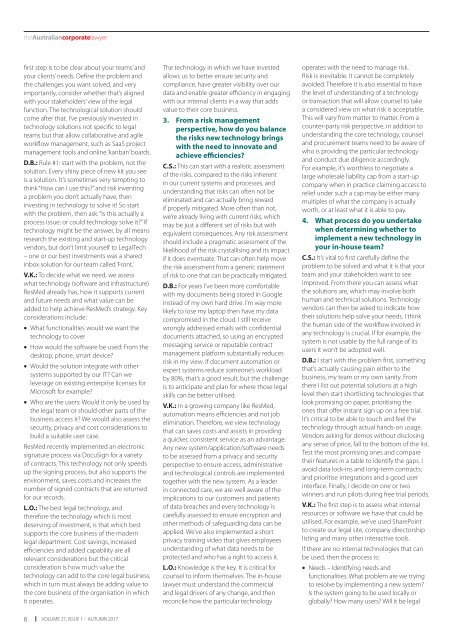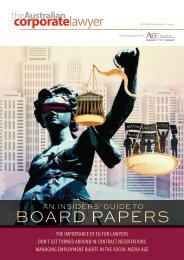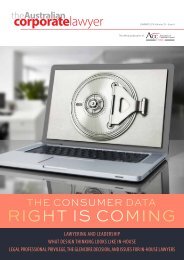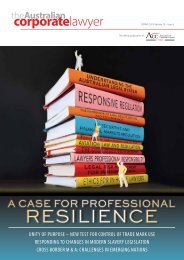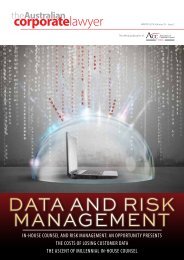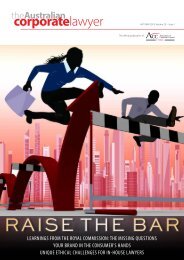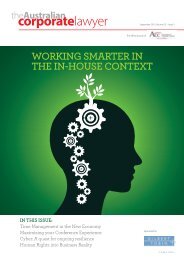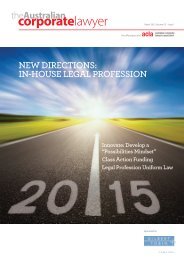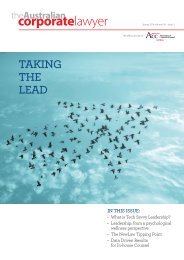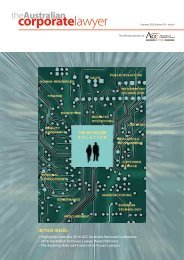Australian Corporate Lawyer - Autumn 2017
Australian Corporate Lawyer is the official publication of the Association of Corporate Counsel (ACC) Australia. The Autumn 2018 issue focuses on 'The Law and Technology' and features a range of articles covering topics including: the future of contracts and; the future of law firms as software companies..
Australian Corporate Lawyer is the official publication of the Association of Corporate Counsel (ACC) Australia. The Autumn 2018 issue focuses on 'The Law and Technology' and features a range of articles covering topics including: the future of contracts and; the future of law firms as software companies..
Create successful ePaper yourself
Turn your PDF publications into a flip-book with our unique Google optimized e-Paper software.
the<strong>Australian</strong>corporatelawyer<br />
first step is to be clear about your teams’ and<br />
your clients’ needs. Define the problem and<br />
the challenges you want solved, and very<br />
importantly, consider whether that’s aligned<br />
with your stakeholders’ view of the legal<br />
function. The technological solution should<br />
come after that. I’ve previously invested in<br />
technology solutions not specific to legal<br />
teams but that allow collaborative and agile<br />
workflow management, such as SaaS project<br />
management tools and online ‘kanban’ boards.<br />
D.B.: Rule #1: start with the problem, not the<br />
solution. Every shiny piece of new kit you see<br />
is a solution. It’s sometimes very tempting to<br />
think “How can I use this?” and risk inventing<br />
a problem you don’t actually have, then<br />
investing in technology to solve it! So start<br />
with the problem, then ask: “Is this actually a<br />
process issue; or could technology solve it?” If<br />
technology might be the answer, by all means<br />
research the existing and start-up technology<br />
vendors, but don’t limit yourself to LegalTech<br />
– one or our best investments was a shared<br />
inbox solution for our team called ‘Front.’<br />
V.K.: To decide what we need, we assess<br />
what technology (software and infrastructure)<br />
ResMed already has, how it supports current<br />
and future needs and what value can be<br />
added to help achieve ResMed’s strategy. Key<br />
considerations include:<br />
• What functionalities would we want the<br />
technology to cover<br />
• How would the software be used: From the<br />
desktop, phone, smart device?<br />
• Would the solution integrate with other<br />
systems supported by our IT? Can we<br />
leverage on existing enterprise licenses for<br />
Microsoft for example?<br />
• Who are the users: Would it only be used by<br />
the legal team or should other parts of the<br />
business access it? We would also assess the<br />
security, privacy and cost considerations to<br />
build a suitable user case.<br />
ResMed recently implemented an electronic<br />
signature process via DocuSign for a variety<br />
of contracts. This technology not only speeds<br />
up the signing process, but also supports the<br />
environment, saves costs and increases the<br />
number of signed contracts that are returned<br />
for our records.<br />
L.O.: The best legal technology, and<br />
therefore the technology which is most<br />
deserving of investment, is that which best<br />
supports the core business of the modern<br />
legal department. Cost savings, increased<br />
efficiencies and added capability are all<br />
relevant considerations but the critical<br />
consideration is how much value the<br />
technology can add to the core legal business,<br />
which in turn must always be adding value to<br />
the core business of the organisation in which<br />
it operates.<br />
The technology in which we have invested<br />
allows us to better ensure security and<br />
compliance, have greater visibility over our<br />
data and enable greater efficiency in engaging<br />
with our internal clients in a way that adds<br />
value to their core business.<br />
3. From a risk management<br />
perspective, how do you balance<br />
the risks new technology brings<br />
with the need to innovate and<br />
achieve efficiencies?<br />
C.S.: This can start with a realistic assessment<br />
of the risks, compared to the risks inherent<br />
in our current systems and processes, and<br />
understanding that risks can often not be<br />
eliminated and can actually bring reward<br />
if properly mitigated. More often than not,<br />
we’re already living with current risks, which<br />
may be just a different set of risks but with<br />
equivalent consequences. Any risk assessment<br />
should include a pragmatic assessment of the<br />
likelihood of the risk crystallising and its impact<br />
if it does eventuate. That can often help move<br />
the risk assessment from a generic statement<br />
of risk to one that can be practically mitigated.<br />
D.B.: For years I’ve been more comfortable<br />
with my documents being stored in Google<br />
instead of my own hard drive. I’m way more<br />
likely to lose my laptop then have my data<br />
compromised in the cloud. I still receive<br />
wrongly addressed emails with confidential<br />
documents attached, so using an encrypted<br />
messaging service or reputable contract<br />
management platform substantially reduces<br />
risk in my view. If document automation or<br />
expert systems reduce someone’s workload<br />
by 80%, that’s a good result, but the challenge<br />
is to anticipate and plan for where those legal<br />
skills can be better utilised.<br />
V.K.: In a growing company like ResMed,<br />
automation means efficiencies and not job<br />
elimination. Therefore, we view technology<br />
that can saves costs and assists in providing<br />
a quicker, consistent service as an advantage.<br />
Any new system/application/software needs<br />
to be assessed from a privacy and security<br />
perspective to ensure access, administrative<br />
and technological controls are implemented<br />
together with the new system. As a leader<br />
in connected care, we are well aware of the<br />
implications to our customers and patients<br />
of data breaches and every technology is<br />
carefully assessed to ensure encryption and<br />
other methods of safeguarding data can be<br />
applied. We’ve also implemented a short<br />
privacy training video that gives employees<br />
understanding of what data needs to be<br />
protected and who has a right to access it.<br />
L.O.: Knowledge is the key. It is critical for<br />
counsel to inform themselves. The in-house<br />
lawyer must understand the commercial<br />
and legal drivers of any change, and then<br />
reconcile how the particular technology<br />
operates with the need to manage risk.<br />
Risk is inevitable. It cannot be completely<br />
avoided. Therefore it is also essential to have<br />
the level of understanding of a technology<br />
or transaction that will allow counsel to take<br />
a considered view on what risk is acceptable.<br />
This will vary from matter to matter. From a<br />
counter-party risk perspective, in addition to<br />
understanding the core technology, counsel<br />
and procurement teams need to be aware of<br />
who is providing the particular technology<br />
and conduct due diligence accordingly.<br />
For example, it’s worthless to negotiate a<br />
large wholesale liability cap from a start-up<br />
company when in practice claiming access to<br />
relief under such a cap may be either many<br />
multiples of what the company is actually<br />
worth, or at least what it is able to pay.<br />
4. What process do you undertake<br />
when determining whether to<br />
implement a new technology in<br />
your in-house team?<br />
C.S.: It’s vital to first carefully define the<br />
problem to be solved and what it is that your<br />
team and your stakeholders want to see<br />
improved. From there you can assess what<br />
the solutions are, which may involve both<br />
human and technical solutions. Technology<br />
vendors can then be asked to indicate how<br />
their solutions help solve your needs. I think<br />
the human side of the workflow involved in<br />
any technology is crucial. If for example, the<br />
system is not usable by the full range of its<br />
users it won’t be adopted well.<br />
D.B.: I start with the problem first, something<br />
that’s actually causing pain either to the<br />
business, my team or my own sanity. From<br />
there I list out potential solutions at a high<br />
level then start shortlisting technologies that<br />
look promising on paper, prioritising the<br />
ones that offer instant sign up on a free trial.<br />
It’s critical to be able to touch and feel the<br />
technology through actual hands-on usage.<br />
Vendors asking for demos without disclosing<br />
any sense of price, fall to the bottom of the list.<br />
Test the most promising ones and compare<br />
their features in a table to identify the gaps. I<br />
avoid data lock-ins and long-term contracts;<br />
and prioritise integrations and a good user<br />
interface. Finally, I decide on one or two<br />
winners and run pilots during free trial periods.<br />
V.K.: The first step is to assess what internal<br />
resources or software we have that could be<br />
utilised. For example, we’ve used SharePoint<br />
to create our legal site, company directorship<br />
listing and many other interactive tools.<br />
If there are no internal technologies that can<br />
be used, then the process is:<br />
• Needs – Identifying needs and<br />
functionalities. What problem are we trying<br />
to resolve by implementing a new system?<br />
Is the system going to be used locally or<br />
globally? How many users? Will it be legal<br />
8 VOLUME 27, ISSUE 1 – AUTUMN <strong>2017</strong>


